“Wanting people to listen, you can’t just tap them on the shoulder anymore. You have to hit them with a sledgehammer, and then you’ll notice you’ve got their strict attention.”
— John Doe, from Se7en
Back in 2005, cartoons in Denmark became an international sensation not for their wit or artistic merit but the death threats made against the cartoonists. The very idea of a cartoon inciting death threats is unbelievable. Almost. But this is the world of a cartoonist who plays with some of the most divisive subject matter on the planet, while at the same time, hopes to arouse a chuckle, in a clever way, and most importantly, to do all of this while getting your attention long enough to enlighten. Welcome to artist, satirist and cartoonist Eric J. Garcia’s world. Here’s a small exchange between the man and someone who is just a little more than in complete awe of Eric J. Garcia, the man, and Eric J. Garcia, the cartoonist.
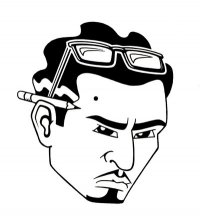
Arguably, there is something subversive about the creative act. The pen is mightier than the sword. Still, the word “artist” is not easily associated with “warrior” (and this is reference to your artist statement). Talk about what it means to use your abilities in such a way.
Many people have this stereotype of an artist being self-absorbed and only caring about their art. But in fact there are many artists who use their art not only for mere self-expression but as a vehicle for a greater purpose. These types of artists are not creating for just aesthetic purposes but rather creating art to be used as teaching tools and even, dare I say, weapons. Warriors have their special abilities and weapons to fight against their enemies, and artists are no different.
Artists use their artistic abilities as weapons to get important messages out, to satirize people and policies and to attack society’s problems with the hopes of starting dialogues and ultimately bringing about change. There are numerous ways, or should I say numerous weapons used to fight against injustice. Some activists use force, some use peaceful protests, and others try to go through the legal system. Artists use their creative abilities as their activism. Some artists use theatre, some use song, and in my case, I use visuals. Many don’t realize the impact images or visuals have on the public. Any government or advertising agency worth their salt knows how the use of imagery can motivate and manipulate people. Call it propaganda if you want, this kind of art is a strategic weapon that militarises, and corporations are most aware of and use ingeniously. Now, this type of art can be used for good, and it can be used for evil. Plenty of governments use the power of visuals to promote war, unjust laws and to alter facts in their favor. Coca-Cola, on the other hand, uses the same tactics but with a different agenda. The Coca-Cola company wants to influence consumers to buy and drink their product. So, as an artist with a socially conscious attitude, why would I not then use this effective, time-proven method of engagement against the forces that are oppressing and causing harm? Instead of trying to promote war and unjust laws, let’s promote peace, and let’s expose the repression caused by unjust laws; instead of altering the facts to make the government look good, let’s unmask the truth and let the people decide. The bottom line is to fight fire with fire, and art is a key weapon.
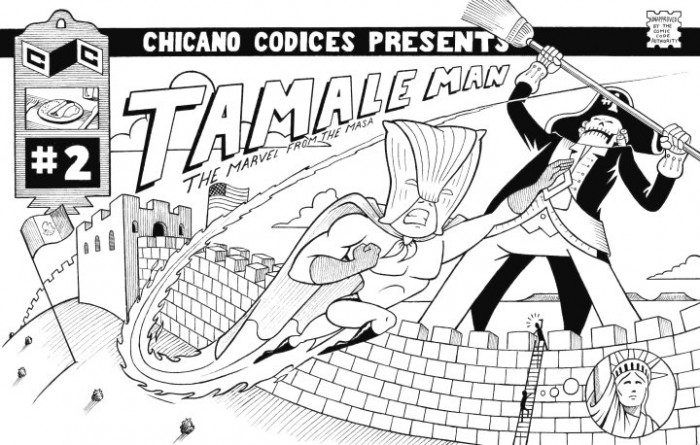
Comic books. While your work is not a comic strip or book, themes of good versus evil, irony, violence and the like are very much alive in your narratives. Superman, the penultimate comic in terms of superheroes, was created and published during a time of fear and uncertainty, during a time just before the death of modernity realized in the World Wars. Do you find your work to be heavily influenced by post-Modernism or even something beyond that—a post-post-Modernism?
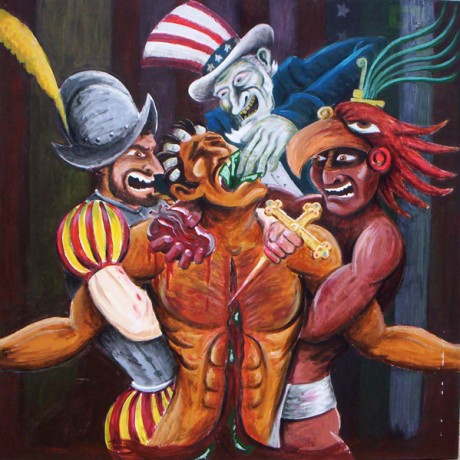
I would say my work is influenced by post-modern art in the sense that I use a variety of media depending on the project I am working on. I intertwine contemporary issues, appropriate popular-culture styles and symbols with personal history, which are all elements that exist in post-modern art. With that said, my biggest artistic influence would not come from academia but from reading comic books and watching cartoons. These were the first forms of art that inspired me at a very early age. Superheroes and cartoon characters were the subjects that inspired me to create and still are. At times when I go to “fine art” exhibits, I am truly disappointed by what I see. Then I go to the comic book store and I am blown away by such tremendous creativity.
The Spanish Colonial Baroque is another genre of art that inspires me. Growing up Catholic and regularly seeing very theatrical narratives on church walls always caught my attention. Much later I realized that these narrative paintings were another link in the timeline of sequential art that would eventually become what today we call comic books. I was fascinated with the idea of telling stories by using visuals and minimal text. This inspired me to create art where the images do the heavy lifting in explaining the narrative and used minimal text as the ribbon that tied the story together. This goes back to the idea of using art not as just something that beautifies the space. The Spanish Baroque was a tool used by the colonial powers. Good or bad, these types of paintings were used as tools to teach people who were either illiterate or who spoke other languages. By using the universal language of visuals, new ideas and stories could be transmitted to far off places where language barriers were prevalent.
Because of my attraction to using art as tool or weapon in a socially conscious way, I think my art would be more accurately categorized as “critical post-modern art,” which is a genre that actually deals with not only the post-modern theory but also with cultural and social consciousness as it relates to post-colonialism. This genre also acknowledges the value of craftsmanship. Leonard Koscianski, in his article “What is Critical Post-Modern Art,” talks about the value of “craft” in critical post-modern art, which I deeply believe in. He writes:
If individual perspectives are important, then artwork, which expresses those perspectives, must be developed seriously even if the content is humorous. For this reason critical postmodern art is often more highly crafted than postmodern works, and often more accessible and communicative. The critical postmodern artist rightly or wrongly assumes that craftsmanship implies respect for the viewer, and enables artwork to communicate more effectively. The critical postmodern artist is ethically engaged in the act of creation rather than ironically detached.
This idea that “craftsmanship” helps the artist communicate with the audience is important to me because I am trying to teach and stir emotions about relevant issues. I want to have a dialogue with my audience, and if my art is not well-crafted, the message is lost, and the art does not work.
I have been criticized on both sides of this issue with my art. I am either a “quick read” and too blunt or the opposite; I do not give enough information for the audience to fully understand what I am getting at. The tricky balancing act I always grapple with is whether to add more information into an art piece to teach or explain an entire issue, or to leave the art piece more bare to let the audience figure out the rest for themselves. I’ve dealt with this issue by using my political cartoons for more aggressive and obvious storytelling, and I try to make my “fine art” more elusive and playful.
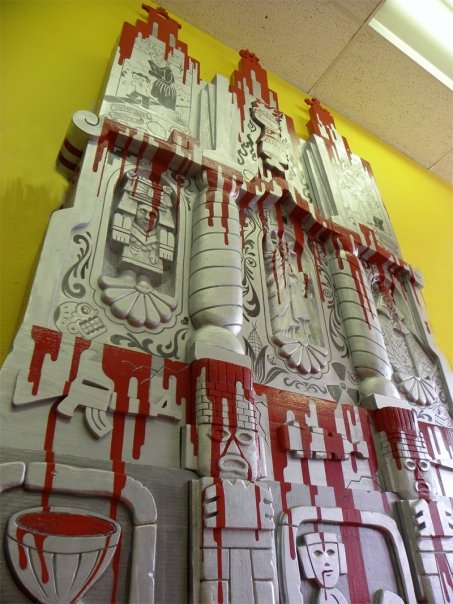
A critique of Joseph Campbell’s “hero” is that the hero comes into a village under duress, saves the village, and then leaves the village just as vulnerable as it once was, thereby necessitating another visit by the hero when danger returns; the village cannot defend itself. This idea of hero has largely remained unchanged. And this happened before Campbell, it’s just that he is oft-cited—as you well know—as the major force in discussions of this nature. Can you talk about the idea of a hero in your work, especially as it is complicated by your focus on educating and challenging the viewer.
Heroes in my work? Other than Tamale Man, I had never really thought too much about the heroes in my artwork. A long time ago, I created Tamale Man, a superhero, in reaction to not finding any Chicano superheroes in comic books. But the focus, like in most of my work, is not about the hero, as much as it is about the enemy he/she is up against. What makes a great hero is actually having a great and even more intriguing arch enemy. Luke Skywalker is nothing without Darth Vader, and Batman is most famous because of all the interesting foes he combats, like the Joker, the Scarecrow, Mr. Freeze and so on. So, too, with Tamale Man. I usually place him in different social political situations. For instance, in Tamale Man #2, he is on the U.S./Mexican border battling the original Minutemen who have risen from the dead to “protect” the borders. This idea of highlighting the enemy is a constant element I play with. I feel most comfortable visualizing a tragic conflict vs. showing the victorious hero saving the day. My work is based on the idea that I present the enemy and hopefully someone from my audience will be the hero who takes action against this foe. No problem can be solved without first acknowledging that there is a problem. I expose the problem using visuals in the hopes that the people will recognize the problem, make that first leap of addressing the issue and hopefully righting the wrong.
I have done some work within the idea of the tragic hero, in particular heroes who have been overlooked or perhaps purposely erased from history. For instance, I have made a couple of pieces on the bandit/Robin Hood figure, Joaquin Murrietta, who was hero to the Spanish-speaking people of California during the Gold Rush of 1849. Murrietta would take revenge on the newly arriving U.S. settlers after Anglo miners threw him off his land and raped and killed his wife. After this, Murrietta began raiding stagecoaches but was eventually hunted down. His decapitated head would eventually be put in a jar of alcohol to be displayed to the public. The Chicano movement in the late 1960s would immortalize Murrietta in the famous poem of that time called “Yo Soy Joaquin.” Figures like this have been lost from our history, and I want to awaken our consciousness of such historical figures through the use of visuals.
One other piece that deals specifically with the idea of a “Hero” is a digitally altered poster called “Evolution of a Hero.” This is a piece where I collaged images together to create a faux movie poster. It deals with the creation of the famous superhero character, Batman. Author Johnston McCully, in the 1920s, ventured to California in search of new inspiration and found the real life adventures of such characters like Joaquin Murrietta and Pío Pico (a rich Don who would lead a resistance against the U.S. invasion). Merging stories of Murrietta and Pico with the swashbuckling literary figure the Scarlet Pimpernel, McCully invented one of the oldest and continually used American fictional heroes, Zorro. This wealthy Don of New Spain, whose secret identity fought for justice, would be the archetype for Bill Finger and Bob Cane’s famous comic book character, Batman.
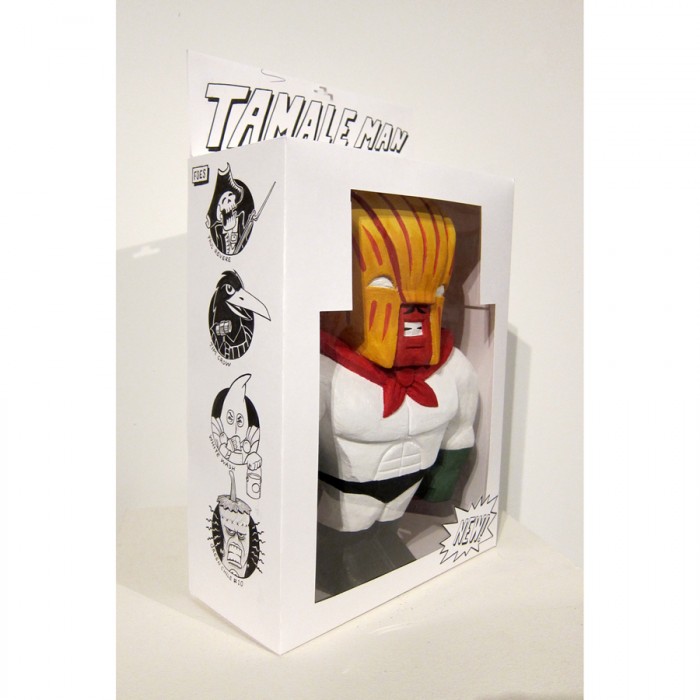
What finally moves you to sit down and create? Is it when you are feeling fierce and ready to lash out? Or is it after great contemplation and meditation? Is it the purge or the catharsis or both or something altogether different that happens as you stare into the canvas? Are you constantly doodling? Are you listening to Enya or Rage Against The Machine while doing this?
History motivates me. I love exploring histories that are crucial in explaining our contemporary situations, which unfortunately are oftentimes erased from mainstream knowledge. These white-washed or simply deleted stories are what motivate me. I feel a certain obligation to reveal these important stories so we can learn from them and understand why things are the way they are.
I work in different ways for different projects. I am constantly doodling. I keep five different sketch books, one medium-size book at my apartment, another larger one to sketch out bigger ideas, one in my backpack, a very small one that I can take anywhere and one specifically dedicated for my political cartoons. I go about making my political cartoons by gathering information all week long which consists of listening to NPR and Democracy Now!, reading news magazines I subscribe to and making little thumbnail sketches throughout the week. I usually don’t listen to music when I work. I’m addicted to listening to the news and trying to stay up-to-date with what’s happening in the world. Sundays are a workday for me because I send my cartoons to my publishers on Mondays. So at the end of every week, I look through my notes and decide what topic to tackle. Larger projects require more planning time. I research information, look for visuals to reference, and decide on the medium that lends itself to the idea of the project. I’m a workaholic and usually have four different projects going at the same time.
Another Chicago artist, Kevin Coval, also finds his inspiration in the neglect and whitewashing of American history. Can you talk about what it means, for you, to have your inspiration in such, well, darkness? And is it significant that you and Coval are both practicing in Chicago? Is there something in the water? No, but seriously folks, is there?
Yes, unfortunately the tragic “darkness” as you put it, is my inspiration. I constantly look for the underdog story, the tragic hero, the victims of history and want to bring these stories into the light so the public can acknowledge them.
I am originally from Albuquerque, New Mexico, and have only been in Chicago for about five years. I came out here for grad school at the School of the Art Institute of Chicago. I don’t know if it’s because of the water, but there is a long history of activism here in Chicago. Heck, this is where May Day started, where the 8-hour day and 5-day workweek was conceived and fought for. Not many people in Chicago, much less the rest of the United States, knows this, so I feel honored to be a part of the activist legacy that is still alive here in Chicago.

Christopher Hitchens, not so much a satirist but often referred to as contrarian—an identity you channel to some degree—spoke about the precarious state of American journalism in its deference to Islamic fundamentalism by not publishing the Danish Jyllands-Posten cartoons. Can you talk a little about what it means to be on the creative side of this situation? And then, what are your thoughts about journalism and self-censorship in light of you being a satirist?
People don’t fully realize the power of images, and the Danish cartoons portraying the prophet Mohammed are a perfect example. There are plenty of political cartoonists that have been imprisoned, beaten and even threatened with death for addressing such sensitive imagery. I think here in the States we take our right of freedom of speech for granted, and the scary part is that this basic right is under attack. As a political cartoonist, I don’t think anything should be censored, but with that, it should be understood that I have a responsibility to the public to use this right of publication for the good of the people and not to just stir up trouble by testing the limitations of my power. This is always a tricky situation because one thing might be acceptable to one person but will be offensive to another. The thing is, a cartoon that offends is what political cartoonists strive for. Political cartoonists love reaction to their work even if it is negative. Negative reactions are an indicator that the art has made an impact. I am flattered when I get hate mail because this means that my art is actually making someone have a reaction. The hope of any political cartoonist is to elicit some kind of reaction from the public, to make them think, to anger them, to inspire them to write a letter and start a dialogue about significant issues.
While the message conveyed in your work is dominating, your work is still art. There are elements in your art—the texture of your lines, the saturation of your colors, the unique signature you lend to your work. Can you talk about your style, technique and its evolution? And can you talk about text/narrative in your work?
My style of art is definitely linked to comic books and their influence on my formation as an artist. Heavy outlines and caricatures are signatures of my graphic style, and I mix those elements with the theatrical allegorical scenes of the Baroque. I also mix in a bit of text to help guide the viewer through the complex narratives of the artwork. I use an assortment of art techniques depending on the project, which range from printmaking, sculptures and installations, to murals.
I believe that the medium I choose has significance. The artwork is made stronger when the medium correlates with the idea. For example, my most recent piece, “The Miracle Under the Cottonwood,” is a large painting created on tin, referencing the folk style of the ex-voto. Ex-voto’s are a Mexican folk art, usually painted on a metal sheets. Normally they depict a miracle that has happened and thus they are made in honor and to give thanks to the saint that assisted with the miracle. Usually ex-votos are small intimate pieces, but I created an oversized allegory that gives thanks to San Antonio, the patron saint of lost things. This painting is about how “Historical” TV shows and movies can easily influence people who are not familiar with actual history. As a youth I was lost and confused about my history and ethnicity. I grew up being influenced by movies like Walt Disney’s version of the battle of the Alamo. Using my mom’s sofa as a fort, I reenacted battle scenes in which I played the defenders of the Alamo, the “good guys” battling the Mexicans who were the “bad guys.” This painting is in honor of Saint Anthony, for helping me find and understand my true history and not the white washed version is saw on television. Ironically, I would later serve in the United States Air Force where I was stationed in San Antonio and trained in defending U.S. military bases.
Lastly, do you have any advice for budding artists/satirists out there? And what’s next for you? Book? Reality tv? Your own clothing and jewelry line?
Advice for artists… work hard, because it’s a lot of hard work. People don’t realize all that being an artist entails. Being an artist is not just about mingling with people at art shows while eating cheese and wine. That’s only a fraction of what we do. Most of our time is spent alone, locked up in the studio working and when we’re not working, we’re researching what to work on. And when we’re not creating our art, then we’re writing about it. Writing artist statements, resumes, bios, descriptions of art and proposals for things not yet made. Then when we’re not writing about our art, we’re documenting our work — documenting our work to put together portfolios, websites and applications for shows and grants. Finally, when we’re not documenting our work, we’re speaking about our work. Speaking at art lectures, speaking to art dealers, speaking to anyone who is interested in our art. Oh — all of this is done on our off-time when we’re not at the day job that pays the bills. The harsh reality is that very few artists make a living solely from their art. So if you want to be an artist, you have to really love making art and will stop at nothing to make it.
Eric J. Garcia’s Current Show:
The Chacmool and the Chalice | Center for Intercultural Programs Student Center | DePaul University, 2250 N. Sheffield Ave — Student Center 103A | Now Thru March 31st | Free